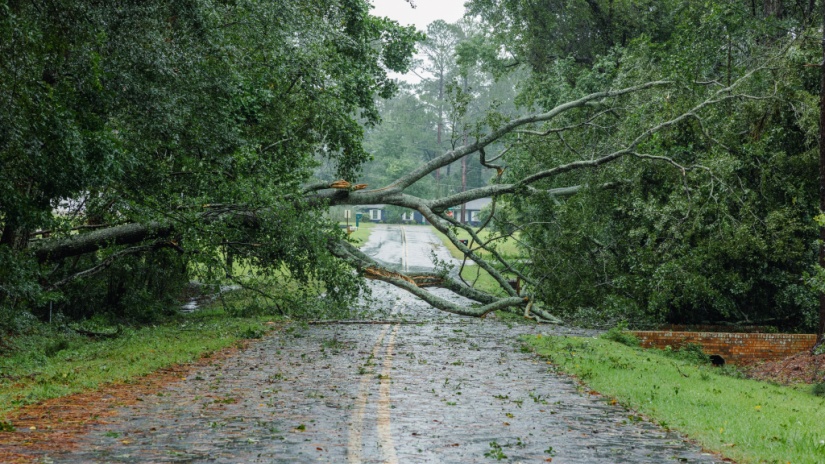Knowledge Centre
Are you ready for Australian storm season?

Those living in Australia are no strangers to the power of Mother Nature. From intense thunderstorms to cyclones, storm season showcases a variety of nature’s forces and potential dangers.
Being prepared is not just a precaution; it’s a necessity. Storm season in Australia usually spans from October to April, with variations depending on your region with some of the strongest storms in the New Year during summer.
During this time, the continent witnesses a variety of severe weather events, including thunderstorms, heavy rainfall, hail, strong winds, and even cyclones in some areas.
Understanding the season’s dynamics in your state is the first step towards preparation.
Storms in Australia: What’s the weather like?
Over the past decade, Australia has experienced numerous severe storms, including thunderstorms, cyclones, and hailstorms. The Bureau of Meteorology's Severe Storms Archive documents these events, with records dating back to the 18th century.
Significant storms in the last ten years include:
- Cyclone Debbie (2017): A Category 4 tropical cyclone that caused extensive damage in Queensland and New South Wales, resulting in 14 fatalities and economic losses estimated at $2.73 billion USD.
- Brisbane Hailstorm (2014): A severe hailstorm that struck Brisbane, causing substantial property damage and economic losses of approximately $1.1 billion AUD.
- South-East Queensland Hailstorm (2020): A supercell thunderstorm that impacted South-East Queensland on 31 October 2020, producing giant hailstones up to 14 cm in diameter and resulting in insurance costs exceeding $980 million AUD.
While these examples highlight some of the most impactful storms, the exact number of severe storms over the past decade is extensive and detailed records can be accessed through the Bureau of Meteorology's Severe Storms Archive.
Should you invest in a generator?
When severe weather strikes, such as during hurricanes or cyclones, losing power is one of the most immediate and frustrating challenges. Extended outages can disrupt daily life, impacting everything from food storage and communication to basic lighting and heating.
An emergency generator offers a practical and invaluable solution, providing a backup power source to keep your household running smoothly in the face of unpredictable weather events.
With natural disasters becoming increasingly common in Australia, owning a generator isn’t just a luxury; it’s a wise investment in your household’s safety, security, and comfort. Beyond powering essential appliances, it offers peace of mind, knowing that you’ll be prepared for emergencies.
Choosing the right generator for your home
One of the most common questions when considering a generator is, “What size do I need?” The answer depends on your household’s power demands.
A smaller generator might suffice for basic needs like powering a fridge, lights, and a few devices, while larger models can support an entire home, including heating or cooling systems. Before purchasing, it’s essential to calculate your household’s energy consumption to ensure you choose a generator with adequate capacity.
Energy costs and long-term considerations
While generators are invaluable during power outages, it’s important to consider the associated energy costs. Generators, whether portable or standby models, run on fuel such as petrol, diesel, or gas. The cost of running a generator can vary depending on fuel prices, the size of the unit, and how long you use it during an outage.
For example, portable generators typically consume less fuel than larger standby models, making them more economical for short-term use. However, for extended outages or high energy needs, the fuel expenses of running a generator can add up.
To save on energy costs, you can prioritise which appliances and devices to power, focusing on essentials like refrigeration, lighting, and communication.
Weighing costs against value
While the upfront cost of purchasing a generator might seem significant, the long-term value it provides during emergencies is well worth the investment. Beyond emergencies, some households find generators useful for other purposes, such as powering tools during DIY projects or camping trips.
However, if your area experiences frequent outages, you might also want to explore alternative power solutions like solar battery systems. These systems store energy generated by solar panels, providing a renewable and cost-effective backup power option.
While the initial investment in solar batteries may be higher than a traditional generator, they offer significant savings on energy costs in the long run and are more environmentally friendly.
A reliable backup for the unpredictable
As natural disasters and power outages become more frequent, investing in a generator is a proactive step to ensure your household stays safe and comfortable.
Whether you opt for a portable power station or a more powerful standby generator, having an off-the-grid power supply means you’re prepared for whatever nature throws your way.
Storm preparation tips
Storms can develop suddenly, catching you off guard if you’re unprepared. Taking proactive steps before dark clouds gather is key to minimising risks and ensuring the safety of your home and loved ones. Here are some essential tips to help you weather the storm season safely.
Taking these precautions before a storm arrives can save you from unnecessary stress and damage. Storms often come and go quickly, but their impact can linger if your home isn’t adequately protected.
With regular maintenance, a little forward planning, and an eye on the weather forecast, you can face storm season with confidence and peace of mind. Stay safe and prepared - because a little effort now can make a big difference later.
Building an emergency kit
When a storm strikes, being well-prepared can mean the difference between safety and chaos. A well-thought-out home emergency kit is your first line of defence against unexpected challenges. Here’s an expanded list of essentials to include, ensuring you and your family are equipped to weather the storm:
Food and water supplies
Plan for at least three days’ worth of non-perishable food and water for each family member. Consider canned goods, dried fruits, granola bars, and other ready-to-eat options that don’t require cooking. Don’t forget a manual can opener! Store at least 3 litres of water per person per day for drinking, cooking, and basic hygiene needs.
Lighting and power solutions
Power outages are common during severe storms, so stock up on flashlights and a generous supply of spare batteries. Consider LED lanterns for a broader light source. A headlamp can also be handy for hands-free use. In addition, invest in solar-powered or crank-powered flashlights for an eco-friendly backup.
First Aid kit and medications
A robust first aid kit is crucial. Include adhesive bandages, antiseptic wipes, gauze pads, tweezers, and scissors. Stock pain relievers, antihistamines, and any prescription medications needed by family members. If someone has specific medical needs, such as asthma or diabetes, ensure you include appropriate supplies like inhalers or insulin.
Communication and connectivity
Staying connected during a storm is essential. Equip yourself with a portable phone charger or power bank to keep your mobile devices operational. It’s also wise to have a battery-powered or hand-crank emergency radio to receive weather updates and emergency broadcasts if mobile networks fail.
Essential documents
Safeguard important paperwork, such as passports, identification cards, insurance policies, and medical records, in a waterproof and fireproof container. Having copies of these documents saved electronically in cloud storage can provide an additional layer of security.
Warmth and comfort items
Storms can bring unexpected temperature drops, so prepare blankets, sleeping bags, and warm clothing for each family member. Thermal or space blankets are compact and effective in retaining body heat.
Tools and emergency gear
Include a multipurpose tool or Swiss Army knife for minor repairs or opening cans. Add duct tape, plastic sheeting, and zip ties for temporary fixes. A whistle can be used to signal for help if needed.
Hygiene and sanitation
Pack moist towelettes, garbage bags, and plastic ties for sanitation purposes. Include toilet paper and basic toiletries like soap, toothpaste, and toothbrushes to maintain hygiene.
Pet supplies
If you have pets, ensure you pack food, water, and any medications they may require. Don’t forget leashes, collars, and a travel carrier in case you need to evacuate.
Evacuation-ready supplies
If evacuation becomes necessary, having a ready-to-go bag with essentials like food, water, medications, and a change of clothes for each person can save valuable time.
Building a comprehensive home emergency kit takes time and careful planning, but it’s an investment in your family’s safety and peace of mind. Keep your kit easily accessible and check it regularly to ensure items like food, water, and batteries are not expired. By preparing in advance, you’ll be ready to face storm season with confidence and resilience.
State-by-state storm warning information
The Bureau of Meteorology (BOM) is your go-to source for severe thunderstorm warnings and updates. BOM provides detailed weather forecasts and alerts through their official website and on their social media platforms.
You can also receive automated weather warnings by calling 1300 659 210. Make it a habit to check the BOM regularly, especially during summer when storms can strike with little warning.
If a major storm impacts your area and you need emergency assistance, the State Emergency Service (SES) is there to help. The SES number is the same across all states and territories - 132 500 - no matter where you’re located in Australia.
To ensure you have quick access to local resources, here are links to the SES websites for each state and territory:
- Queensland SES
- New South Wales SES
- Australian Capital Territory SES
- Victoria SES
- Tasmania SES
- South Australia SES
- Western Australia SES
- Northern Territory SES
Being prepared and informed is key to minimising risks during Australia’s storm season. Regularly monitor the BOM for weather updates, know your local SES contact details, and have a storm safety plan in place.
How to save energy during storm season
By taking the right steps, you can not only reduce your energy usage but also ensure your home is prepared for potential power outages. Here are the top ways to save energy during storm season:
Maximise natural light
Storm season is often accompanied by cloudy skies, but when the sun is shining, make the most of natural light to reduce the need for artificial lighting. Open curtains and blinds during the day to brighten your space without relying on electricity.
Unplug unused appliances
Storms can lead to sudden power surges, which not only increase energy use but can also damage your appliances. Unplug any devices or appliances that aren’t in use, such as chargers, TVs, or computers, to save energy and protect them from electrical surges.
Stick to energy efficient lighting
Swap out traditional lightbulbs for energy-efficient LED bulbs. They use significantly less electricity and are more durable, making them ideal for storm season when power reliability may be an issue.
Limit your HVAC use
Storm season often brings fluctuating temperatures. Instead of relying heavily on air conditioning or heating, use natural methods to regulate indoor temperatures. Keep windows closed during storms to prevent cold drafts and use fans or portable heaters sparingly.
Get your fridge and freezer optimised
Your refrigerator and freezer are among the biggest energy consumers in your home. Keep them stocked but not overfilled, as this helps maintain a consistent temperature and reduces energy use. During a storm, avoid opening the fridge or freezer unnecessarily to keep food cold for longer if the power goes out.
Use surge protectors
Installing surge protectors for your appliances not only protects them from damage during a storm but also allows you to control and reduce energy usage. Some surge protectors have energy-saving features, such as automatic shut-off for idle devices.
Switch to solar
If you have solar panels, consider pairing them with a battery storage system. This allows you to store excess energy during sunny periods for use during storms or power outages. Solar-powered devices, such as outdoor lights or chargers, can also reduce dependence on the grid.
Regularly maintain your key systems
Regularly clean and maintain your home’s key systems, such as air conditioners, heaters, and appliances, to ensure they run efficiently. Dirty filters or poorly functioning equipment can increase energy consumption, especially during peak storm season.
Invest in better insulation
Storms often bring extreme weather conditions that can impact your home’s temperature. Energy-efficient windows and proper insulation help maintain a comfortable indoor climate while reducing the need for heating or cooling.
Monitor your standby power
Appliances in standby mode still consume energy, often referred to as "phantom power." Use power boards with individual switches or unplug devices to eliminate unnecessary energy consumption.
Be prepared and energy-efficient
Storm season doesn’t have to mean higher energy bills. By adopting these energy-saving practices, you can reduce your electricity usage, lower costs, and prepare your home for the challenges that come with severe weather. A little planning and preparation can go a long way toward creating a storm-ready, energy-efficient household.
With the help of Compare Energy, you can swap your energy plan to one that suits your budget and your business with no hiccups. You'll be ready for the cost - physically and financially - of storm season with our help and prep!

